Feb 4, 2017 | Canada, coins, education, video
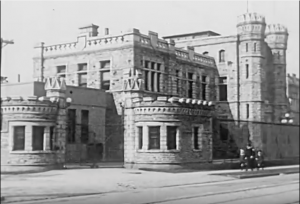
1920 Image of the Royal Canadian Mint in Ottawa
Take the video below, for example. It is titled “How money is Made” and appears to have been made for the Royal Canadian Mint by a company called Mogull Brothers Film Library in New York.
A quick bit of Internet research shows the company was founded and run by Charles Mogull (1898-1986) in Brooklyn, New York. Mogull Brothers were one of the early content creation pioneers. They would shoot a film on various subjects, edit them into smaller features, and sell the features to companies that would use them in larger compilations. Their content would be everything from features like the one they created for the Royal Canadian Mint, news events, interviews, show promotions, etc. and footage they would buy from photographers. The little information I could find on Mogull suggests that the company ceased operation in the late 1950s.
As for the film, the architecture of the original Royal Canadian Mint in Ottawa looks like a castle. I believe I read somewhere that the Royal Canadian Mint still uses the building as storage. To see this marvelous looking structure and to visit the Mint appears to be a good excuse to visit the Canadian capital.
It is a silent film that the person who posted it to YouTube added music. Even with the music, you can see how film technology has changed. Rather than being able to overlay the wording over the image, a process called keying, printed cards are used to describe the content and spliced into the film.
At the moment the film shows the making of the dies, they show the dies of a 1920 Canadian one cent coin with the image of George V. It was under George V, shortly after his ascension to the throne, that the Parliament Act 1911 transferred a lot of governing power to the House of Commons and started the erosion of monarch’s power.
Although we are well into the industrial revolution, the mix of automation and human interaction is fascinating. For example, starting around the 8-minute mark, there is a man bouncing the coins listening for its distinctive ring that silver coins make when bounced on a hard surface. Nowadays, machines with sensors and computers check the coins for quality. Even circulating coins are rarely touched by human hands.
Finally, as a little comic relief, when the film shows the title cards, look in the lower right corner at the graphics they chose to use. The filmmaker tried to use the graphics to emphasize something about what you will see next.
Now enjoy the show:
Jan 25, 2017 | coins, foreign, fun, video
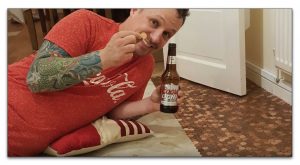 Let’s have some fun rather than talk about the mundane! Covering floors, cars, or any other surface using coins is not something new, but according to Matt Giles this has not been done in the United Kingdom. On the YouTube page where the video is posted, he writes:
Let’s have some fun rather than talk about the mundane! Covering floors, cars, or any other surface using coins is not something new, but according to Matt Giles this has not been done in the United Kingdom. On the YouTube page where the video is posted, he writes:
When thinking about what to lay in the kitchen Amy came up with a fantastic idea inspired by what she had researched online. We saw a bunch of penny floor projects in the USA, it seemed a really popular way of creating a bespoke retro floor for any part of the house, but wasnt done in the UK. Challenge accepted!
We took 27,000 1p coins and decided to give our kitchen diner a new look. Each coin was individually glued to the floor which had been self levelled before hand and left to dry. After gluing down all the coins a black grout was applied to fill the gaps followed by a high gloss epoxy resin to cover and seal.
The end result is simply awesome. The floor looks stunning and the weeks of hard work has been worth the pain.
Seems like an inexpensive idea. Take £270 in pennys (yes, that is how the Brits spell the plural of penny), glue, grout, apply a high gloss epoxy resin, and take about two weeks of work to come up with something different. For anyone curious, £270 is currently equivalent to $337.88.
Maybe his video will inspire your creativity!
Dec 7, 2016 | bullion, gold, US Mint, video
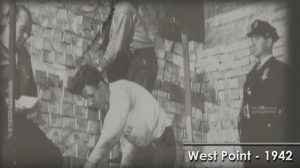
Gold storage at West Point in 1942 (screen grab)
Gold stored at West Point is called “working stock.” This is the gold that the U.S. Mint uses for striking coins. Depending on the demand, the gold you will see in the video will not be there in a year. It will be used for American Gold Eagles, gold commemoratives, and gold medals cast for congress and the president.
West Point has been called “The Fort Knox of Silver” because it is where the U.S. silver reserve is located. It is also the location for the working stock of silver used by the U.S. Mint. All of the U.S. Mint facilities have working stock of silver used to strike silver coinage. However, since most gold production is struck out of West Point and Philadelphia, most of the working stock of gold is in those facilities.
West Point is the primary manufacturer of gold bullion coins.
In the video at the 50-second mark, someone is weighing a bar of gold. He says the manufacturer claim is that it weighs 400.100 (troy ounces) but actually weighs 400.096. A gold bar weighing 400.096 troy ounces is 12.444 kilograms or 27.435 pounds. With the price of gold currently $1,176.60 per troy ounce (as this is being written), the melt value of that gold bar, which is .9999 fine looking at the stamp on the bar, is $470,752.95.
Video courtesy of the U.S. Mint.
Oct 9, 2016 | medals, silver, US Mint, values, video
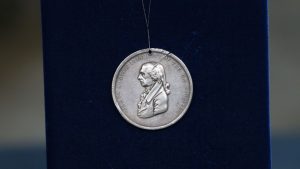 Finding coins in pocket change can be a lot of fun. Then there are those who find hoards of coins buried in the ground or just stored somewhere that people forgot. From shipwrecks to treasure hunts, we all dream of finding the next jackpot somewhere.
Finding coins in pocket change can be a lot of fun. Then there are those who find hoards of coins buried in the ground or just stored somewhere that people forgot. From shipwrecks to treasure hunts, we all dream of finding the next jackpot somewhere.
On your great grandfather’s farm, a worker was plowing the field and found a silver medal. It has the image of President James Madison on one side and what looks like a peace medal on the other. Rather than letting go, great grandpa traded three hogs for the medal.
The medal gets handed down from generation to generation until one of his ancestors takes the medal to Antiques Roadshow to find out what it is worth.
You are told that it is a silver James Madison Indian Peace Medal. The 1809 medal was designed by assistant engraver John Reich and struck at the U.S. Mint in Philadelphia. It is not the largest of the medals but at 2½-inches, it is a fairly significant medal.
What is it worth? See what Jason Preston of Jason Preston Art Advisory & Appraisals of Los Angeles said about the medal on Antiques Roadshow:
Did you guess right?
Image and video courtesy of
WGBH and the Antiques Roadshow
Jul 3, 2016 | currency, education, Federal Reserve, news, video
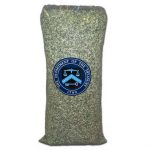
5 lb. bag of shredded currency contains $10K in cash
We have seen the many packages of shredded currency. From the little packages with $5.00 of shredded currency to 5 pound bags filled with approximately $10,000 shredded money, this was the primary way currency did not just get thrown away. Since 2014, the Federal Reserve has been working with recyclers across the country to turn that shredded cash into something else useful.
According to the Federal Reserve Bank of San Francisco, the Federal Reserve pushed for more recycling of currency in 2011. Since each Federal Reserve bank manages its own cash operations each works with local recyclers to provide the cash. In most cases, the recycler hauls away the shredded cash for no charge to the bank and turns it into other products.
Examples of what is done with the cash is that the San Francisco district supports burning of the shreds for “green power,” a fitting name for recycling U.S. currency. So does the Federal Reserve Bank of Philadelphia.
The story caught my eye was about the New Orleans branch of the Federal Reserve Bank of Atlanta that provides shredded currency to a company that composts the cash, mixes it with other soil so that it is used for growing vegetables.
If compost is not your idea of fun, how about using the shreds to make art:
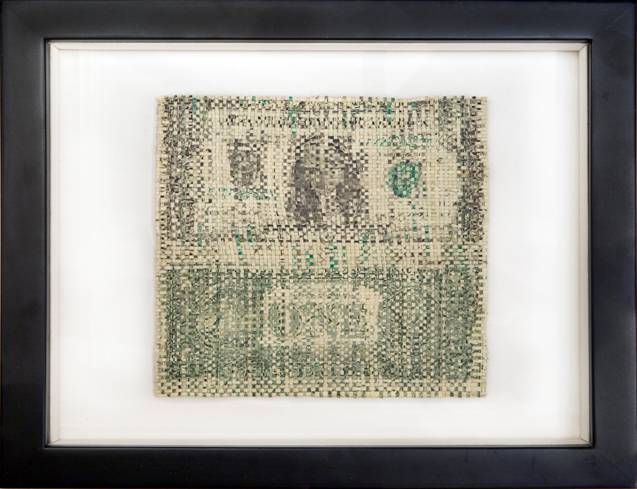
“Another Day, Another Dollar”
Artist: Jason Hughes
Sadat Art for Peace (2012): First Prize, Category: 2 Dimensional
Medium: American Currency
Jun 16, 2016 | bullion, coins, Eagles, US Mint, video
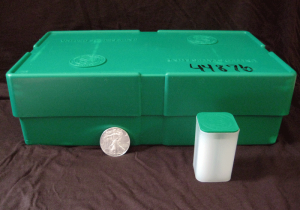
American Silver Eagle Monster Box
Another of my guilty pleasures is How It’s Made on the Science Channel. How It’s Made is simply a show that will demonstrate how every day and other items are manufactured. I am fascinated by seeing the process of manufacturing. Some of the machines that are created to make our everyday items is fascinating. Take something simple as a pencil and think about how a company makes thousands over the course of a day and the non-standard machines required to do this.
The U.S. Mint infrequently posts videos about their coins, people and operations. What I find fascinating is the How It»s Made like videos that shows how they deal with the basic manufacturing process. In the latest video, the U.S. Mint shows how they package American Silver Eagle bullion coins into tubes for shipping to dealer.
The machine is called an Auto Tuber and can be found at the West Point branch mint where bullion coins are struck. After the coins are struck, they are laid flat on trays with the trays being stacked on a rack. From the rack, a machine takes one of the trays, places it next to the Auto Tuber, and pours the coins into the tracks. Using a suction cup fingers, the machine lifts the coins and places them into tube. The tubes are capped, weighed, packaged, inventoried, and sent for shipping.
At the end of the line is a human worker who picks up the packed green boxes you might have seen some dealers advertise for sale as “Monster Boxes” and places them on a pallet for shipping. That is where the one-minute journey ends.
BONUS VIDEO
Similar to the standard production videos is the proof set production video from the U.S. Mint in San Francisco that includes a similar machine that places the coins in the holders.
Credits
- Monster box image courtesy of Wikipedia.
- Videos courtesy of the U.S. Mint.
Jun 12, 2016 | coins, news, shows, video
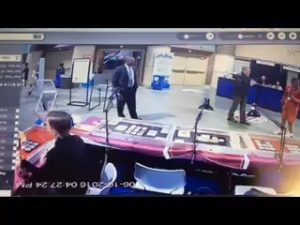 Watchers of the @coinsblog Twitter feed have seen that I post storied of robberies of coin collections. These are heart breaking stories not because the owner lost something of value. They lost something of emotional value.
Watchers of the @coinsblog Twitter feed have seen that I post storied of robberies of coin collections. These are heart breaking stories not because the owner lost something of value. They lost something of emotional value.
I have seen stories of a stash of mostly Morgan silver dollars that have been stolen from a dresser draw that the owner either has saved all of these years or were from a relative who saved them as part of a hedge from a depression. There was a story that a young single mother found gold coins in her late father’s house and was going to use the coins to care for her children only to have someone she trusted later steal the coins. Then the story of the Flying Eagle and Indian Head cent collection with most coins in almost uncirculated quality including a 1909-S coin put together by a late grandparent that was stolen while the family was on vacation.
While these are heartbreaking, it is great to hear about the community working together to capture a thief.
Two thieves went to the Long Beach Expo looking to cash in on their ill-gotten gain when a dealer thought he recognized the coins as described from an earlier robbery. The dealer notified on-site security who apprehended the criminals. They were handed over the Long Beach police.
It is wonderful that the community will pay attention to these unfortunate incidents and help law enforcement recover these coins!
This is the press release was issued on behalf of Positive Protection, Inc.Positive Protection, Inc. of Temecula, California, and in cooperation with Stack’s Bowers Galleries of Santa Ana, California.
Positive Protection Guard Tackles
Suspected Coin Thief In Long Beach
(Long Beach, California) — A suspected thief was tackled by a Positive Protection, Inc. (
www.ppius.com) security guard as he tried to escape at the Long Beach Coin, Currency, Stamp & Sports Collectible Expo (
www.LongBeachExpo.com) on Friday, June 10, 2016. An alleged accomplice with a backpack containing more than $300,000 of rare coins was also taken into custody.
Both suspects were turned over to Long Beach police on suspicion of burglary, robbery and possession of stolen property. Two other suspects were arrested the next day and more stolen coins were recovered.
“They reportedly were trying to sell coins at the Long Beach Expo in the Long Beach Convention Center. One dealer they approached, Karl Stephens, thought the coins they were offering had been stolen earlier in a robbery in the San Bernardino, California area,” said Patrick Coward, a guard for Positive Protection of Temecula, California, a company that provides security services for coin and jewelry dealers.
“When the suspects tried to leave, the dealer shouted out to stop them. I was nearby and when one suspect started to run I chased him and tackled him at the door. Additional security personnel from the show helped subdue him. The second suspect was stopped without a problem at the door as he tried leave. His backpack was filled with more than 100 ancient coins and other gold and silver coins worth more than $300,000,” explained Coward, a former New York City homicide detective.
The brief chase and the tackle were captured on surveillance video at the booth of Stack’s Bowers Galleries (
www.stacksbowers.com) of Santa Ana, California and New York City.
“With the help of a knowledgeable dealer and the fast action of trained security professionals, two suspected thieves were caught and valuable, stolen rare coins have been recovered,” said Robert Brueggeman, President of Positive Protection which provides on-site security for all the Whitman Expo and American Numismatic Association convention shows. “We always want a safe, enjoyable environment for dealers and the public at these collectible shows, but we also must always be on alert.”
A day after the capture of the two suspects at the coin show, Long Beach Police arrested two more suspects who reportedly came to retrieve the car of the first two suspects. Investigators recovered from the car what is believed to be the remainder of the stolen rare coins.
This surveillance video shows Positive Protection, Inc. security guard and former New York City Police homicide detective Patrick Coward on the left as he immediately chased and tackled a suspected coin thief when the suspect tried to flee from a coin show in Long Beach, California on Friday, June 10, 2016. His alleged accomplice is then stopped at the door while carrying a backpack with a reported $300,000 in rare coins believed stolen in an earlier theft in the San Bernardino, California area.
Stacks Bowers Long Beach Surveillance Video
Video courtesy of Stack’s Bowers Galleries.
May 14, 2016 | BEP, currency, dollar, video
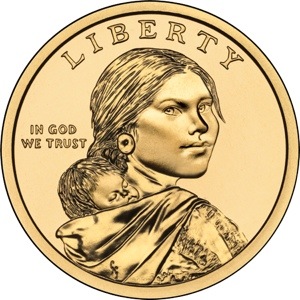
Obverse of the 2009-present Native American Dollar featuring the portrait of Sacagawea
I will go into the more details of the changes at a later date, but during my travels around the interwebs I came across a television news report from KIFI, the ABC affiliate in Fort Hall, Idaho. Although it is like every other news story it has one feature that no other news outlet was able to add to their story: an interview with Randy’L Teton.
Randy’L Teton is a member of the Shoshone-Cree tribe who was the model for Glenna Goodacre’s design for the Sacagawea dollar coin. Teton was a student at the University of New Mexico majoring in art history and was working for the Institute of American Indian Arts Museum in Santa Fe when Goodacre visited looking for Shoshone woman to be her model since no images of Sacagawea exist. Teton was chosen for as the model.
For anyone who has not seen or heard Ms. Teton, here is the video of KIFI’s report:
May 12, 2016 | celebration, coins, nickels, video
If you missed the news, a few days ago President Barak Obama signed the National Bison Legacy Act (Pub. L. 114-152) that names the “North American Bison” the national mammal. The bison does not replace the Bald Eagle as the national animal or the national emblem.
The bison is an iconic animal unique to North America. Discovered by the European settlers as the country expanded west, the bison was significant to the economic and spiritual lives of the native tribes throughout the Great Plains areas.

Photo from the 1870s of a pile of American bison skulls waiting to be ground for fertilizer.
Although conservation efforts began in the late 19th century, a bison population that used to number in the millions the 2012 Department of Agriculture census said that there were 162,110 heads. Up until the last 50 years, we have done a bad job of taking care of this national resource, now national treasure.
When numismatist thinks of the American Bison, the thought turns to the Indian Head “ Buffalo” Nickel designed by James Earle Fraser. Fraser, a student of Augustus Saint-Gaudens, continued the path of Theodore Roosevelt’s “pet crime” to design a coin that screams America.
The reverse of the coin is an American Bison that we erroneous call a buffalo. According to legend, Black Diamond was Fraser’s model for the reverse of the Buffalo nickel. Black Diamond was a North American bison that was living in the Central Park Zoo. He was donated to the zoo by Barnum and Bailey and lived his life there until he was auctioned in 1915 to a game and poultry dealer who was later sold as steaks for $2 a pound.
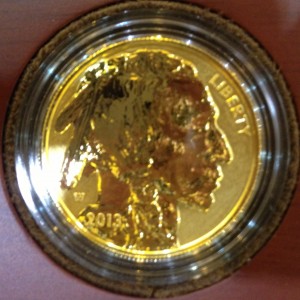
2013-W American Buffalo gold reverse proof obverse
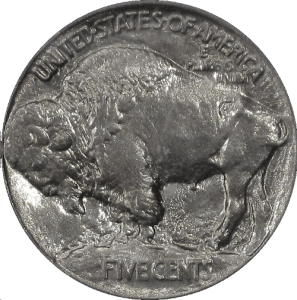
1913 Buffalo Nickel Type 1 Reverse
When asked about the model for the coin, Fraser said it was Black Diamond and found him in the Bronx Zoo. At one time Fraser was not sure of the name of the animal but insisted his influence was at the Bronx Zoo. Black Diamond was never at the Bronx Zoo. But like the story of who was the model for the Indian on the obverse, why should facts spoil a good story!
With the signing of the National Bison Legacy Act there are groups that wants to bring back the Buffalo nickel. Someone started a petition at the online petition website Change.org to convince the U.S. Mint to return to bring back the buffalo nickel.
Even though the U.S. Mint is the wrong agency to address this petition to since it would require an act of congress, the Fraser Buffalo design is still used on the 24-karat gold bullion coin. In fact, not counting varieties, mintmarks and strike types, the bison has appeared on eight different coins and one Legal Tender Note. If you want to put together a nice type set, it would require 22 different coins and the 1901 $10 Legal Tender Note (see “Collecting a Herd of Buffaloes” for this discussion).
I do not know if returning the Buffalo nickel is a good idea. While it was an iconic design, it was one that saw considerable wearing while in circulation. If someone wants to bring the buffalo back to United States coins, maybe we could consider the 2005 Westward Journey nickel with the American Bison reverse. It also has a better portrait of Thomas Jefferson than is currently used.
If you would like to virtually sign the partition, visit Change.org and register your vote.
The Washington Post produced an interesting video with facts about the bison. If you want to see the video without visiting the Post’s website, you can watch it here:
Bison images and the Type 1 Buffalo nickel reverse courtesy of Wikipedia.
Mar 26, 2016 | coins, education, US Mint, video
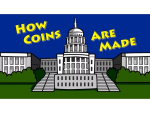 Since the beginning of the year, the U.S. Mint has been issuing a lot of video content primarily videos regarding the launch of America the Beautiful Quarters coins and B-Roll video. This past week, the U.S. Mint issued a new “How Coins Are Made… For Kids!” video as part of their H.I.P. (History In your Pocket) Pocket Change educational program.
Since the beginning of the year, the U.S. Mint has been issuing a lot of video content primarily videos regarding the launch of America the Beautiful Quarters coins and B-Roll video. This past week, the U.S. Mint issued a new “How Coins Are Made… For Kids!” video as part of their H.I.P. (History In your Pocket) Pocket Change educational program.
As opposed to prior videos, rather than have the entire video animated, it uses a combination of animation and the B-Roll video the U.S. Mint published last month. It is done in a way that tells a very coherent story without being cheesy. Everyone will enjoy this video, even if they are just a kid at heart.
If you have an interest in good videos that have been issued by the U.S. Mint you should subscribe to their YouTube Channel. Some of the recent videos that I recommend include an interview with Cassie McFarland, design contest winner for the 2014 National Baseball Hall of Fame Commemorative Coin; B-Roll showing the sculptor-engravers at the Philadelphia Mint; Episode 1 of their “My Favorite” where they interview San Francisco employees about their favorite coins; and “Maryland Quarter in Space” interview with William Krawczewicz, designer of the Maryland State Quarter after Maryland and Florida coins traveled aboard the New Horizons spacecraft.
What is B-Roll
“B-Roll” is a television term for background video that is interspersed within a story. It received its name from the days of editing video segments on film where the primary film that contained the story with the reporter talking was on the “A” or primary roll of film. During the story, there would be other elements cut in with background and other video that was on another reel called the B-Roll. The term has survived through the video and now digital era. Modern B-Roll is now called stock footage.

 Let’s have some fun rather than talk about the mundane! Covering floors, cars, or any other surface using coins is not something new, but according to Matt Giles this has not been done in the United Kingdom. On the
Let’s have some fun rather than talk about the mundane! Covering floors, cars, or any other surface using coins is not something new, but according to Matt Giles this has not been done in the United Kingdom. On the 




 Watchers of the
Watchers of the 




